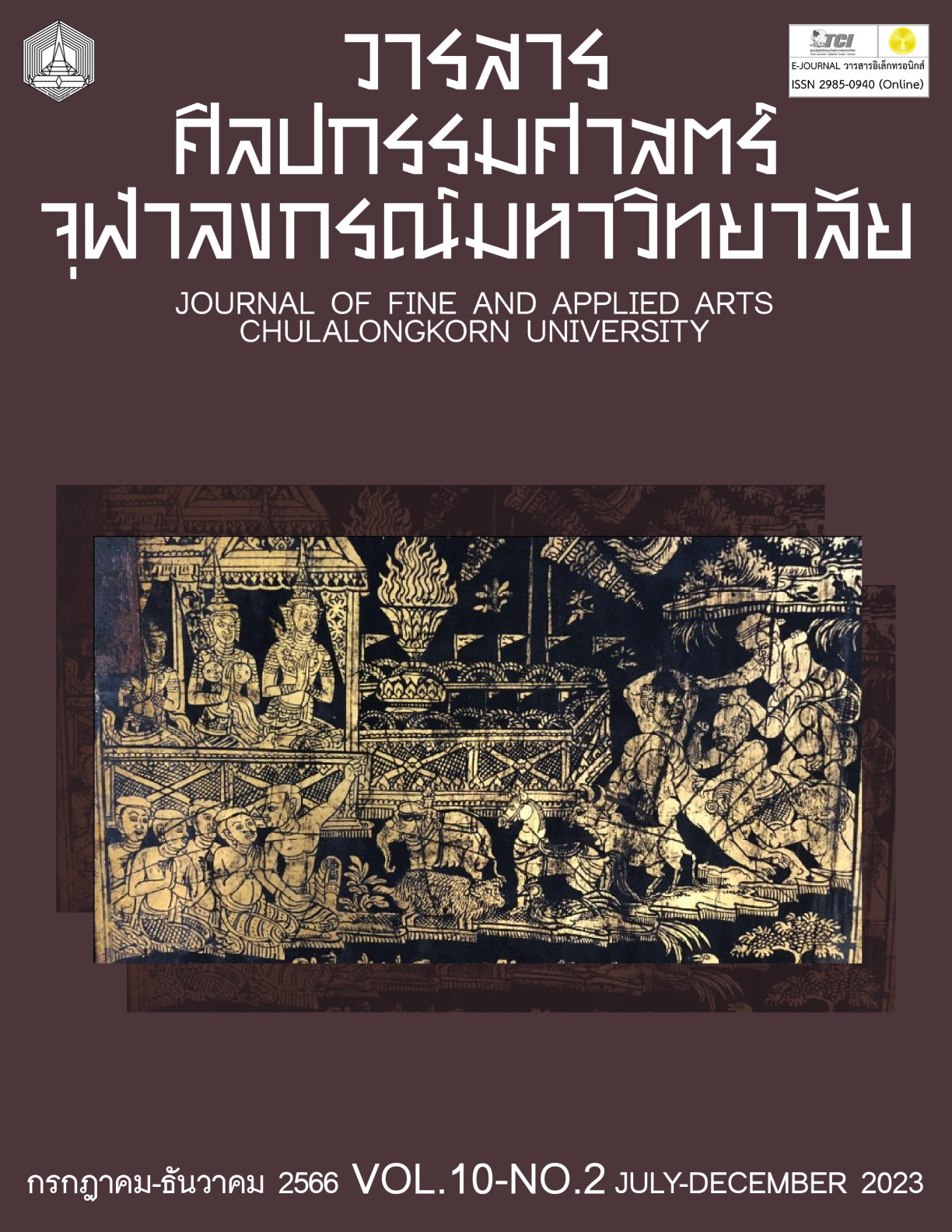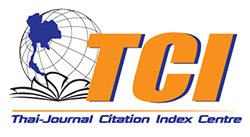IDEA CONCERNING TO BEING THAI CULTURE AND THAINESS FROM PRINCE DAMRONG RAJANUBHAB’S WORKS ON THAI CLASSICAL MUSIC AND THE DEVELOPMENT OF THAI CULTURE AND THAINESS (1959-1988)
Keywords:
idea, Thai classical music, prince Damrong Rajanubhab, culture, ThainessAbstract
The research aim to study idea concerning and relationship between idea concerning to being Thai culture and “Thainess” from Prince Damrong Rajanupap’s work on Thai classical music and government policy in Thai culture and “Thainess”. The findings revealed that Prince Damrong Rajanupap status is as a high-ranking royal family member who also held the position of Chancellor of the Ministry of the Interior. Therefore, he played an important role in strengthening the stability of governance and upholding the monarchy. His concept of “Thainess” was to highlight the role of the monarch in the status of ruler, which brings prosperity and happiness to the people of the whole kingdom. As a central feature of state power, Thai music was considered a high art form that is part and parcel of the royal court’s entertainment and ceremonies. Therefore, Thai music was an integral part of the civilization that is related to the monarchy. This means that the works of Thai composition is limited to the music of the royal court or the music of the center of state power at that time. That music is clearly distinct from music by region or city in the rest of the kingdom.
Thai music in the era of Prince Damrong Rajanupap consists of the following four themes: (1) “Describing the Musical Instruments;” (2) “Legends of Mahori;” (3) “Legends of Lakhon Inao;” and (4) “Legends of Sapa.” Each theme attaches great importance to the examination of the interpretation of evidence which are not always well-documented in the historical record of the same period. As a historian who is regarded as the father of Thai history, he applied his knowledge to explain the history of Thai music. This included the concept that Thai music is influenced by India. The various influences of the scope of Thai music and the articulation of Thai music history continues through the study and activities of Thai music by the Fine Arts Department. The key player in passing on such knowledge is Montri Tramote, an important Thai national artist and scholar.
Starting in the era of Field Marshal Sarit Thanarat (1959-1963) to General Prem Tinsulanonda (1980-1988), there began a progressive deterioration of traditional Thai culture. In addition, foreign Communist influence was considered a threat to national security. Thus, successive government administrations decided to promote a national cultural identity of “Thainess” to help solidify the population under a unified theme. An important component of this cultural identify was Thai music, which was encouraged to be learned, taught, and passed on through subsequent generations. An “Office of National Cultural Commission” was established, and this entity organized dissemination of Thai musical activities. In this way, the foundation of “Thainess” laid by Prince Damrong Rajanupap would continue to have influence in modern times.
References
Chulalongkorn. Royal speech of King Chulalongkorn (from 1908 to 1910). Bangkok: Sophon Phiphatthanakorn Printing House, 1915.
พระบาทสมเด็จพระจุลจอมเกล้าเจ้าอยู่หัว. พระราชดำรัสในพระบาทสมเด็จพระจุลจอมเกล้าเจ้าอยู่หัว. (ตั้งแต่ พ.ศ. 2451 ถึง พ.ศ. 2453). พระนคร : โรงพิมพ์โสภณพิพรรฒธนากร, 2458.
Damrong Rajanubhab. “Explication of the Gamero legend.” In Gamero Chapter Meeting and Explanation of the Gamero Legend, 1-26. Phra Nakorn: Sophonpipatthanakorn Printing House, 1928.
สมเด็จฯ กรมพระยาดำรงราชานุภาพ. “อธิบายตำนานมโหรี”. ใน ประชุมบทมโหรีกับอธิบายตำนานมโหรี, 1-26. พระนคร : โรงพิมพ์โสภณพิพรรฒธนากร, 2471.
Damrong Rajanubhab. “Lectures on the Chronicle of Siam.” In The cremation ceremony of Mr. Boo Rueangwiset, 1-201. Bangkok: n.p., 1949.
สมเด็จฯ กรมพระยาดำรงราชานุภาพ. “แสดงบรรยายพงษาวดารสยาม.” ใน งานฌาปนกิจศพนายบู่ เรืองวิเศษ, 1-201. กรุงเทพฯ : ม.ป.พ., 2492.
Damrong Rajanubhab. Legend of Thai verse. Phra Nakhon: Thai Printing House, 1925.
สมเด็จฯ กรมพระยาดำรงราชานุภาพ. ตำนานเสภา. พระนคร : โรงพิมพ์ไทย, 2468.
Damrong Rajanubhab. “Legend of the Piphat Musical Instrument.” In The Cremation Ceremony of Khunying Manopakorn Nititthada, 1-23. Bangkok: n.p., 1930.
สมเด็จฯ กรมพระยาดำรงราชานุภาพ. “ตำนานเครื่องมโหรีปี่พาทย์.” ใน งานพระราชทานเพลิงศพคุณหญิงมโนปกรณ์นิติธาดา, 1-23. กรุงเทพฯ : ม.ป.พ., 2473.
Damrong Rajanubhab. Panji tales. 4th edition. Phra Nakhon: Klang Wittaya Publishing House, 1965.
สมเด็จฯ กรมพระยาดำรงราชานุภาพ. ตำนานเรื่องลครอิเหนา. พิมพ์ครั้งที่ 4. พระนคร : สำนักพิมพ์คลังวิทยา, 2508.
Damrong Rajanubhab. Tales of Archeology. Bangkok: Amorn Phim, 1972.
สมเด็จฯ กรมพระยาดำรงราชานุภาพ. นิทานโบราณคดี. กรุงเทพฯ : อมรการพิมพ์, 2515.
Eawsriwong, Nithi. Western Historiography. N.P.: n.p., 1976.
นิธิ เอียวศรีวงศ์. ประวัติศาสตร์นิพนธ์ตะวันตก. ม.ป.ท.; ม.ป.พ., 2519.
National Archives. MOE Division. 0701.9.10.6.1/7 Culture Commission.
หอจดหมายเหตุแห่งชาติ. กอง ศธ. 0701.9.10.6.1/7 กรรมการฝ่ายวัฒนธรรม.
National Archives. MOE Division. 0701.9.1/35 Development Plan for the Northeast Region.
หอจดหมายเหตุแห่งชาติ. กอง ศธ. 0701.9.1/35 แผนพัฒนาภาคตะวันออกเฉียงเหนือ.
Office of the National Economic and Social Development Council. “National Economic and Social Development Plan No. 5, 230.” https://www.nesdc.go.th/ewt_dl_link.php?nid=3780.
สำนักงานสภาพัฒนาการเศรษฐกิจและสังคมแห่งชาติ. “แผนพัฒนาเศรษฐกิจและสังคมแห่งชาติฉบับที่ 5, 230.” https://www.nesdc.go.th/ewt_dl_link.php?nid=3780.
Royal Gazette. Act of the Office of the National Cultural Commission, 1979. Volume 26, Section 40, March 23, 1979.
ราชกิจจานุเบกษา. พระราชบัญญัติสำนักงานคณะกรรมการวัฒนธรรมแห่งชาติ พ.ศ. 2522. เล่ม 26 ตอนที่ 40, 23 มีนาคม 2522.
Royal Gazette. Announcement of the Office of the Prime Minister on National Cultural Policy. Volume 98, Section 201, 8 December 1981.
ราชกิจจานุเบกษา. ประกาศสำนักนายกรัฐมนตรี เรื่อง นโยบายวัฒนธรรมแห่งชาติ. เล่ม 98 ตอน 201, 8 ธันวาคม 2524.
Sattayanurak, Saichol. A History of the Thinking about Thai Society and Culture from the Viewpoints of Thai Intellectuals (1892-1992). Bangkok: The Research Fund Office, 2007.
สายชล สัตยานุรักษ์. โครงการประวัติศาสตร์วิธีคิดเกี่ยวกับสังคมและวัฒนธรรมไทยของปัญญาชน (พ.ศ. 2435-2535). กรุงเทพฯ : สำนักงานกองทุนสนับสนุนการวิจัย, 2550.
Tramote, Montri. Lectures of the subject of Thai music. Bangkok: Silpasanong Printing, 1997.
บุญธรรม ตราโมท. คำบรรยายวิชาดุริยางคศาสตร์ไทย. กรุงเทพฯ : ศิลปสนองการพิมพ์, 2540.
Tramote, Montri. M. P. Miscellany. Bangkok: Institute of Thai Studies. Chulalongkorn University, 1995.
มนตรี ตราโมท. ม.ต. ปกิณกนิพนธ์. กรุงเทพฯ : สถาบันไทยศึกษา จุฬาลงกรณ์มหาวิทยาลัย, 2538.
Wichitwatakarn. “The Fine Arts Department (part relating to the duties of the provincial governor).” In The First Director-General of the Fine Arts Department, Maj. Gen. Luang Wichitwathakan, 66-69. Bangkok: Chong Charoen Printing, 1892.
หลวงวิจิตรวาทการ. “การศิลปากร (ส่วนที่เกี่ยวกับหน้าที่ข้าหลวงประจำจังหวัด).” ใน อธิบดีคนแรกของกรมศิลปากรพลตรีหลวงวิจิตรวาทการ, 66-69. กรุงเทพฯ : จงเจริญการพิมพ์, 2435.
Wirunrak, Suraphon. Dance in the reign of King Rama IX. Bangkok: Chulalongkorn University Press, 2006.
สุรพล วิรุฬห์รักษ์. นาฏยศิลป์รัชกาลที่ 9. กรุงเทพฯ : สำนักพิมพ์แห่งจุฬาลงกรณ์มหาวิทยาลัย, 2549.
Downloads
Published
Issue
Section
License
Copyright (c) 2023 ภัทรวดี ภูชฎาภิรมย์

This work is licensed under a Creative Commons Attribution-NonCommercial-NoDerivatives 4.0 International License.
ลิขสิทธิ์ของบทความเป็นของเจ้าของบทความ บทความที่ได้รับการตีพิมพ์ถือเป็นทัศนะของผู้เขียน
กองบรรณาธิการไม่จำเป็นต้องเห็นด้วยและไม่รับผิดชอบต่อบทความนั้น






